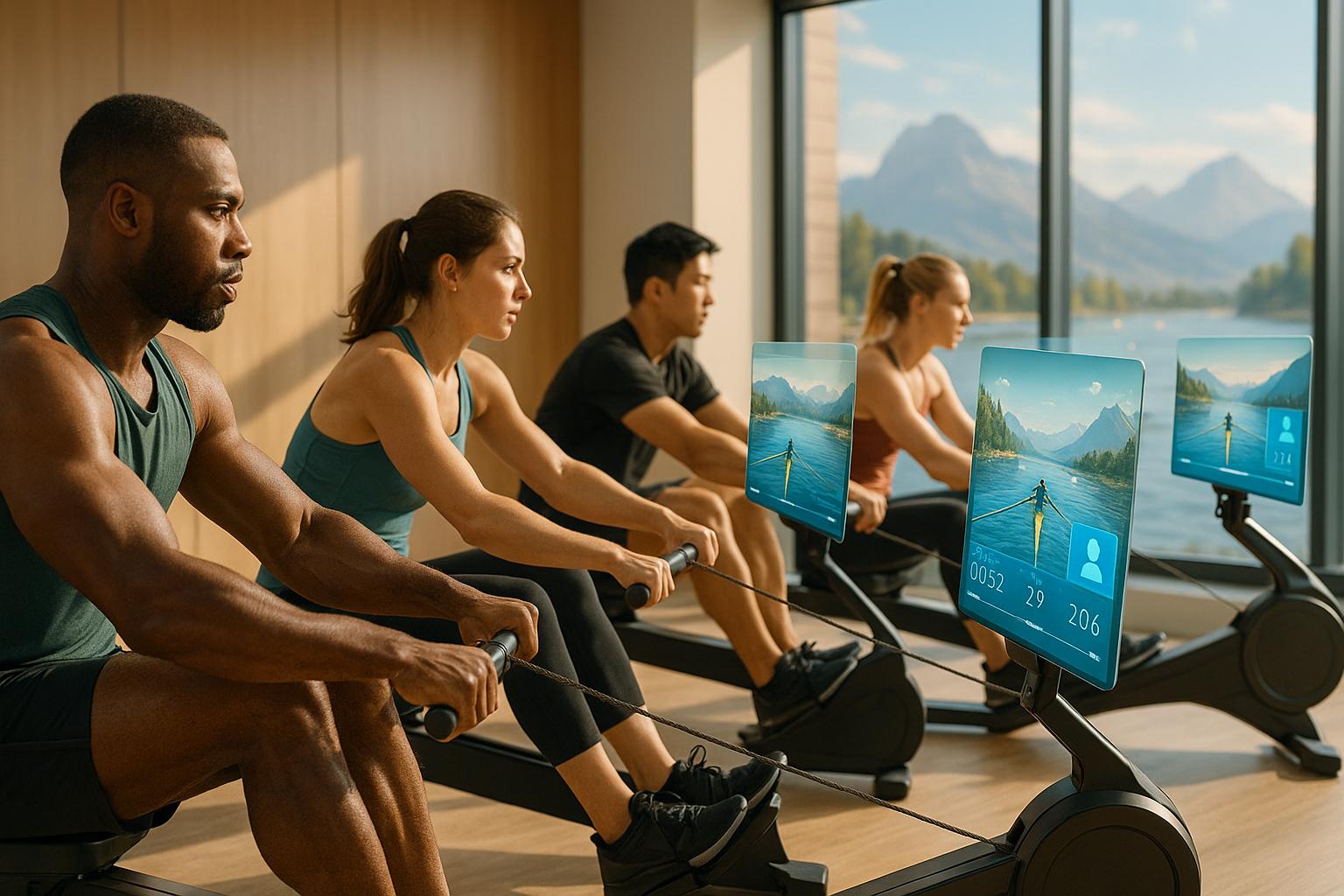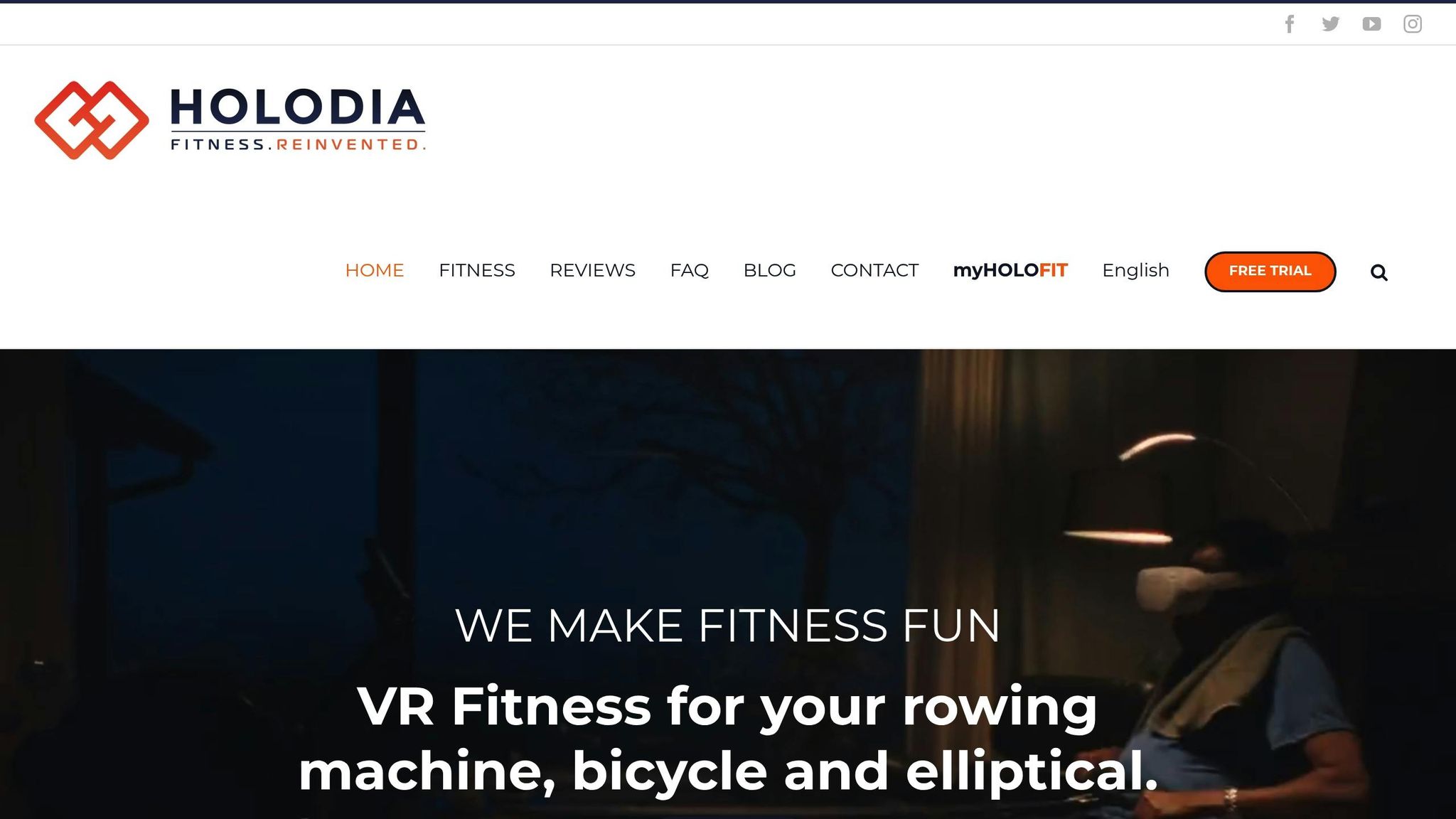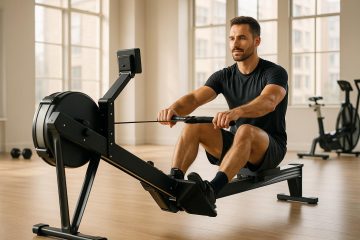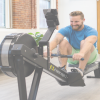
Emerging Trends in Virtual Rowing Competitions 2025
Virtual rowing is transforming how people approach fitness in 2025. Combining gamification, immersive technologies like VR/AR, and AI-driven coaching, it offers an engaging, tech-forward way to stay active. The sport is growing rapidly, with the global rowing simulator market projected to reach $256 million this year, fueled by rising demand in the U.S. and beyond. Key advancements include:
- Gamification: Features like leaderboards and achievement systems boost user engagement by up to 80%.
- Immersive Tech: VR/AR creates interactive environments, from virtual lakes to stadiums, enhancing workout experiences.
- AI Coaching: Real-time feedback and personalized training programs improve performance and reduce injuries.
- Global Reach: Virtual events and connected platforms unite rowers worldwide, breaking barriers of geography and accessibility.
From AI-powered tools to gamified platforms, virtual rowing is reshaping fitness and competition, making it more interactive and accessible than ever.
Gamification and User Engagement
Gamification Features and Results
Gamification has breathed new life into virtual rowing, with features like leaderboards, achievement systems, and interactive challenges driving impressive results. Leaderboards alone inspire 70% of users, while achievement systems increase active user engagement by 30%. Interactive challenges take it a step further, boosting participation rates by 65%. Together, these elements help platforms retain 80% of users over six months – a stark contrast to the 20% retention seen on non-gamified platforms.
Users recognized through achievement systems are 50% more likely to stay engaged, and 70% report feeling more motivated when they can visually track their progress. ProForm‘s 2024 gamified rowing workouts highlight this trend, leading to a 31% spike in app downloads and a 24% increase in usage frequency. Notably, nearly 35% of younger fitness enthusiasts prefer this interactive approach. Tom Aulet, Founder of Ergatta, captures this sentiment perfectly:
"Gaming makes rowing more fun and habit-forming".
Further supporting the appeal of gamification, 83% of participants in gamified sports report feeling more motivated and excited compared to traditional methods. Personalized fitness challenges also play a key role, with participants 50% more likely to stick with the platform after three months . When combined with immersive technologies, these gamified experiences take user engagement to the next level.
Immersive Technologies in Virtual Rowing
Virtual Reality (VR) and Augmented Reality (AR) are redefining indoor rowing by creating deeply engaging environments. VR transports users to serene lakes, turbulent rapids, or even virtual stadiums, offering a fully immersive experience. Meanwhile, AR overlays digital data onto the real world, allowing users to monitor their form and performance without losing awareness of their surroundings.
One standout innovation is RowAR, a prototype unveiled in July 2023 that seamlessly blends VR and AR. This hybrid approach transforms rowing workouts into captivating experiences. As one representative explained:
"RowAR represents a remarkable leap forward in the fitness industry, leveraging the power of Virtual Reality and Augmented Reality to transform rowing workouts into immersive and captivating experiences…making workouts more exciting than ever".
The benefits of VR extend beyond engagement – real-time feedback has been shown to enhance performance. This growing interest in immersive fitness solutions is reflected in the numbers: the global online/virtual fitness market, valued at $16.4 billion in 2022, is expected to grow at an annual rate of 26.72% through 2030. Connected rowers, which combine app-based coaching with features like leaderboards, now account for 31% of fitness tech preferences, showcasing the powerful synergy between gamification and immersive technology.
Some Call It a Workout, We Call It a Game | HOLOFIT VR Fitness

AI-Powered Coaching and Training
Artificial intelligence is reshaping virtual rowing by offering tailored coaching experiences that cater to each athlete’s specific needs. The AI sports market is booming, with projections estimating it will hit $29.7 billion by 2032, growing at an annual rate of 30.1% starting from 2023. This rapid growth highlights AI’s ability to revolutionize training through instant insights, injury prevention, and customized coaching. These advancements are paving the way for real-time performance improvements.
Real-Time Feedback and Performance Data
AI-powered tools are redefining how rowers receive feedback during workouts. By tracking movements in real time, these systems provide immediate insights into efficiency, power, endurance, and technique. Unlike traditional methods that analyze performance after the workout, AI solutions allow athletes to make adjustments on the spot.
Take ImersU, for example. Their advanced AI coaching platform connects rowers from over 50 countries, continuously analyzing stroke mechanics. It adjusts resistance levels and modifies stroke rates to align with individual goals. ImersU describes their approach as:
"Train Smarter, Not Harder – Get real-time analytics that monitor every movement. Optimize your efficiency with AI-driven insights. Improve power, endurance, and technique with data-backed feedback."
With advanced motion tracking, rowers receive immediate feedback on their technique, pace, and form. Studies show that AI-powered wearables have reduced sports-related injuries by 30%, making training not just more effective but also safer.
Personalized Training Programs
AI takes training customization to the next level, moving beyond generic programs. By analyzing an athlete’s performance, recovery, and goals, these systems create workouts that adapt in real time. Factors like body composition, injury history, and performance metrics are all considered, ensuring the training evolves as the athlete progresses.
Athletica is a prime example of this technology in action. Used by world champion rowers like Martino Goretti, the platform adjusts workout volume, intensity, and stroke rate based on performance and recovery data . Athletica users praise its flexibility:
"Athletica adapts to all of that. It keeps me on track, fits around my life, and gets me to the finish line." – Tom Watson
"It adapts in real time based on how I’m actually responding – not just following a one-size-fits-all training plan. That means smarter sessions, fewer setbacks, and no burnout." – Holli Bradish-Lane
These platforms go beyond physical metrics, incorporating factors like sleep quality, caloric intake, hydration, and mental resilience to create a well-rounded training approach. Many systems sync seamlessly with equipment like Concept2 machines, ensuring accurate data collection and real-time adjustments. Metrics such as resting heart rate and heart rate variability (HRV) provide deeper insights into how an athlete is responding to their training regimen.
Global Participation and Community Growth
Virtual rowing has grown into a worldwide phenomenon, connecting athletes across the globe. The numbers tell the story: the global rowing machine market hit $0.49 billion in 2024 and is expected to grow to $0.52 billion by 2025, maintaining a steady annual growth rate of 5.24% through 2033. This surge highlights how virtual platforms have successfully removed traditional barriers, making rowing more accessible to people everywhere.
Breaking Barriers with Connected Fitness
Connected fitness platforms have revolutionized accessibility, allowing rowers from different time zones to train and compete together. The connected gym equipment market reflects this shift, expanding from $2.98 billion in 2024 to a projected $4.86 billion by 2030, with an annual growth rate of 8.35%.
In the U.S., the adoption of indoor fitness equipment is on the rise, with 38% of households owning such tools and 26% favoring rowers as their go-to workout machine. Virtual fitness programs have fueled a 33% increase in smart rower purchases, leading to a 29% boost in gym installations and a 31% jump in online sales. A significant milestone came in June 2025, when iFIT Inc. rolled out its iFIT AI Coach (beta) across 19 countries. This move underscores how tech companies are driving global access to virtual rowing. These innovations are reshaping the sport, blending inclusivity with cutting-edge technology to create dynamic, tech-driven competitions.
Building Community Through Virtual Events
Beyond accessibility, virtual events are fostering a sense of community among athletes. These events enable competitors to engage internationally while forming meaningful connections.
British Rowing and EXR have tapped into this potential by hosting regular online competitions that continue to draw participants from around the world. Fergus Mainland, an experienced athlete, captures this spirit:
"I think people love to test themselves and be part of something bigger than themselves."
He also highlights how group rows in the EXR app bring rowers together:
"The group rows in the EXR app allow rowers to be connected across the globe and make new friends while staying active and even spending more time on the rowing machine than expected!"
The 2025 World Rowing Virtual Series adds another layer of excitement. This event features four monthly challenges designed to test various ergometer skills, inviting rowers to submit scores and compete globally. Participants can earn virtual badges or diplomas to celebrate their achievements.
Vincent Gaillard, World Rowing’s Executive Director, emphasizes the importance of these advancements:
"The rise of Indoor/Connected Rowing is phenomenal, and having a robust set of rules is a crucial step in its continued growth. This move not only reinforces the integrity of competition but also enhances opportunities for athletes at all levels to engage in the sport, whether in physical arenas or virtual settings."
The British Rowing Indoor Championships (BRIC) exemplify how virtual events unite diverse athletes. These competitions bring together fitness enthusiasts, Olympians, and CrossFit stars, showcasing a mix of skill levels and backgrounds. British Rowing’s global membership now exceeds 30,000 participants, creating a platform where rowers of all levels can learn, grow, and find inspiration in one another.
Directory Platforms and Virtual Rowing
As virtual rowing continues to grow with features like gamification and AI-driven coaching, having a centralized directory can make it much easier to explore the expanding options. Platforms like RowingList.com serve as a hub, offering curated listings of rowing apps, equipment, coaching services, and workout programs – all designed to help users quickly find the right fit for their needs.
Finding Virtual Rowing Products and Services
Take RowingList.com as an example. It’s tailored specifically for the rowing community, categorizing everything from mobile apps and rowing machines to coaching services and workout plans. Whether you’re searching for gamified training apps, AI-powered coaching tools, or connected fitness equipment, this platform simplifies the process of finding resources that align with your goals.
Another standout feature is its ability to integrate with popular platforms like the Concept2 Logbook and Strava. This means users can track their performance and monitor progress seamlessly across their virtual rowing activities. The directory’s structured layout also includes discipline-specific filtering, which is especially useful for narrowing down options – something we’ll explore in the next section.
Organized Listings and Discipline Filtering
RowingList.com doesn’t just list resources – it organizes them into categories like indoor rowing, on-water rowing, and virtual rowing. This setup allows users to quickly locate and compare products or services that match their specific discipline. For virtual rowing enthusiasts, especially those preparing for competitions, this filtering system is a game-changer. It eliminates the hassle of sorting through unrelated equipment, helping users focus on tools designed for their unique needs.
Support for U.S. Users
Platforms like RowingList.com also cater to U.S. users by offering localized listings in USD. For businesses, the platform provides flexible pricing options for featured placements: $30 for 30 days, $75 for 90 days, or $120 for 180 days. These options make it accessible for both emerging startups and established companies to reach the growing U.S. audience. At the same time, free listing options ensure smaller developers can still get their products in front of potential users.
For U.S.-based consumers, these directories are an invaluable resource. They simplify the process of finding the right tools – whether you’re gearing up for international virtual competitions or looking for engaging fitness solutions to use at home. With clear guidance and tailored listings, platforms like RowingList.com make navigating the virtual rowing world a whole lot easier.
The Future of Virtual Rowing Competitions
The world of virtual rowing is changing quickly, with 2025 shaping up to be a landmark year for blending technology with a growing global community. These advancements are not just about improving individual performance – they’re redefining how accessible and engaging the sport can be for people everywhere.
Key Developments
One of the biggest breakthroughs? AI-powered coaching. The market for AI coaching tools is expanding fast, with projections showing significant growth by 2033. A notable example is the 2023 collaboration between FIRST DEGREE FITNESS and a fitness AI company. Together, they launched a rowing machine with built-in virtual coaching, leading to longer workouts and happier users.
On top of that, gamification and immersive technology are making waves. Smart rowing machines are flying off the shelves, and gyms are installing them at a growing rate. Why? These features make workouts more engaging and interactive.
The sport is also seeing a surge in global participation. For instance, World Rowing’s Virtual Indoor Sprints drew 5,047 competitors from 88 countries. The February 2025 Virtual Rowing Indoor Championships further highlighted this growth, with standout performances by Belgian rower Ward Lemmelijn and U.S. athlete Elizabeth Gilmore.
To support this expanding ecosystem, directory platforms like RowingList.com are becoming essential. With over 45% of consumers choosing rowing for its full-body benefits and nearly 38% of U.S. households owning indoor fitness equipment, these platforms help users navigate the growing number of virtual rowing tools and services.
These trends set the stage for even more innovation and community building in the years ahead.
What Lies Ahead
The future of virtual rowing is all about deeper tech integration and stronger global connections. For example, World Rowing’s participation in the 2025 Esports World Cup in Riyadh and its partnership with the Japan Sport Council for the Virtual Sports Forum in March 2025 underscore the sport’s digital ambitions.
"By creating engaging formats such as the Virtual Series, World Rowing is helping to foster a global Indoor Rowing community, create new competitive pathways, and offer rowers of all levels fresh ways to connect with the sport – whether from their home, gym, or rowing club."
– World Rowing
Accessibility and inclusivity are expected to take center stage as AI coaching becomes more advanced. With about 30% of adults in high-income countries not getting enough physical activity, virtual rowing’s ability to deliver customized, adaptive training could help bridge this gap. However, there’s a fine balance to strike – research shows that overly challenging virtual programs can hurt performance rather than help it.
The rise of connected fitness is another key trend. Cloud-based software is quickly becoming the go-to standard for AI rowing apps. Meanwhile, the growing use of smartphones and wearable devices is making it easier to track performance and connect with the rowing community.
As these innovations unfold, AI coaching and gamification will continue to reshape the sport. World Rowing President Jean-Christophe Rolland captured the moment perfectly:
"We are witnessing a fundamental shift in how people engage with sport, and Indoor Rowing is at the forefront of this transformation".
This transformation is paving the way for a more inclusive, engaging, and interconnected future for competitive rowing, bringing together athletes from around the globe like never before.
FAQs
How does AI coaching improve performance and reduce injuries in virtual rowing?
AI-driven coaching in virtual rowing takes performance to the next level by analyzing your technique and delivering customized feedback. This helps fine-tune your form, boost efficiency, and improve results. With real-time insights, you can adjust your strokes on the spot, ensuring every session is as effective as possible.
Another major advantage is injury prevention. These systems carefully track your biomechanics and workload, flagging risky movements or signs of overtraining before they become a problem. This proactive monitoring keeps athletes healthier, enabling smarter training and reducing the chances of setbacks that could derail long-term progress.
How do gamification and immersive technologies enhance engagement in virtual rowing competitions?
Gamification and immersive technologies are transforming virtual rowing competitions, making them far more engaging and fun. Gamification brings in features like challenges, leaderboards, and rewards. These elements spark friendly competition, push participants to stay active, and help them aim for better performance. Workouts become less of a chore and more of an exciting, goal-oriented adventure.
On the other hand, immersive technologies like augmented reality (AR) and virtual reality (VR) take things to a new level. They create realistic rowing experiences, letting users feel as though they’re gliding through scenic rivers or battling it out in international regattas. This sense of realism adds a thrilling edge to each session, making it unforgettable. Together, these tools build a deeper emotional connection, encouraging users to return time and time again.
How are virtual rowing competitions encouraging global participation and building a strong community among athletes?
Virtual rowing competitions are reshaping the sport by allowing athletes to join in from anywhere in the world. Take the 2025 World Rowing Virtual Series, for example. Running from June 1 to September 30, 2025, this event welcomes rowers of all skill levels to compete remotely, breaking down geographical barriers and uniting a diverse global community.
These events are also tapping into modern tools like gamification, AI-powered performance tracking, and collaborations with organizations like Concept2. The result? A more interactive and connected experience that builds a sense of camaraderie among participants. Virtual rowing is turning individual efforts into a shared global passion for the sport.










